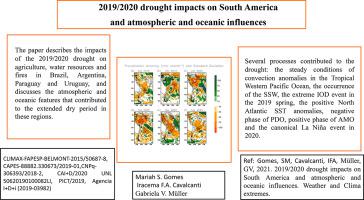Weather and Climate Extremes ( IF 6.1 ) Pub Date : 2021-11-30 , DOI: 10.1016/j.wace.2021.100404 Mariah Souza Gomes 1 , Iracema Fonseca de Albuquerque Cavalcanti 1 , Gabriela V. Müller 2, 3

|
The 2019/2020 drought in South America caused many impacts on several sectors, as agriculture, water resources and environment, which are reported here. Besides, there is a discussion about anomalies in the atmosphere and ocean during the analyzed period. In a regional scale, there was a reduction of humidity flux over the continent, and in a large scale, the occurrence of different processes could have contributed to the dry conditions. There was a persistent pattern of west-east convection anomalies in the tropical Pacific that could be related to the steady conditions observed over South America and southeast South Atlantic from September 2019 to March 2020. The extreme positive phase of the Indian Ocean Dipole during 2019 austral spring was another event that could have influenced temperature and precipitation in South America through a wavetrain from the Indian Ocean to the South American continent. The Sudden Stratospheric Warming that occurred in September 2019 induced the negative phase of the Southern Annular Mode in December, which generated subsidence over the subtropics and affected the precipitation over South America. In addition, from September 2019 to March 2020, the heating observed in the stratosphere propagated to the troposphere over South America. Ocean indices from 1982 to 2020 are analyzed in the context of dry conditions in the continent and it was observed the relations with AMO, PDO, IOD and El Niño 3.4. From September 2019 to March 2020, there were positive SST anomalies in all oceans, mainly in the North Atlantic Ocean, which could have contributed also to subsidence over South America through a meridional circulation, as seen in other cases. At the end of the studied period, the development of La Niña extended the situation of reduced precipitation in Southern Brazil.
中文翻译:

2019/2020 年干旱对南美洲的影响以及大气和海洋的影响
南美洲 2019/2020 年的干旱对农业、水资源和环境等多个部门造成了许多影响,此处报告了这些影响。此外,还有关于分析期间大气和海洋异常的讨论。在区域尺度上,大陆上的湿度通量减少,而在大尺度上,不同过程的发生可能导致了干燥条件。热带太平洋存在持续的东西向对流异常模式,这可能与 2019 年 9 月至 2020 年 3 月在南美洲和南大西洋东南部观察到的稳定条件有关。2019 年南半球春季期间印度洋偶极子的极端正相位是另一个可能通过从印度洋到南美洲大陆的波列影响南美洲温度和降水的事件。2019 年 9 月发生的平流层突然变暖导致 12 月出现南环模负相位,造成亚热带下沉,影响南美洲降水。此外,从 2019 年 9 月到 2020 年 3 月,在平流层中观测到的热量传播到南美洲上空的对流层。1982 年至 2020 年的海洋指数在大陆干燥条件下进行分析,观察到与 AMO、PDO、IOD 和厄尔尼诺 3.4 的关系。2019年9月至2020年3月,所有海洋都存在正 SST 异常,主要是在北大西洋,这也可能通过经向环流导致南美洲的沉降,如在其他情况下所见。研究期末,拉尼娜现象的发展扩大了巴西南部降水减少的局面。











































 京公网安备 11010802027423号
京公网安备 11010802027423号